Author: Jo Ann
of Luv'N Chins
Grooming Seminar
In March, 2003, we had a seminar sponsored by Jamie and the Chinchilla Club and hosted by Lee and Iris Musselwhite of Circle M Ranch in North Carolina. Karen Hill of Alyssum Acres was kind enough to go through the various steps demonstrating the proper way of grooming a chinchilla. Lee demonstrated how chins are judged at a show. I would like to take this time to thank all of them for a job well done, a very informative day, and last but definitely not least ... all the fun we had.
We all love our little chins and try our best to care for them properly. How and with what we use, to care for them with, is extremely important. Things we may think are harmless may hurt or damage them, things we think may harm them does not, but is good for them. This is the main reason for this or any seminar ... to learn what is best for our little ones. This seminar was to show how to groom a chin for a show, but chinchillas need to be groomed on a regular basis to keep their fur in the best possible condition at all times. It is best to start as soon as they are weaned so that they do not get stressed by doing something new in a strange place.
Below are some of the grooming tools necessary to take care of your chin ... not only for a show, but on a regular maintenance schedule. You will note there are two different groups ... the one on the left are proper grooming tools, those on the right are not.
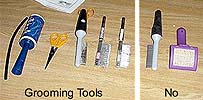
The two grooming tools on the right are used for cats and dogs. Chinchilla fur is not as thick as a cat or dog's fur (even though it is much more dense) and can be damaged by these tools on the left. Your chinchilla combs should be combs made especially for chinchilla grooming.
Karen first showed us why it is necessary to groom your chinchilla. 'Breaks' or the separation of the fur on a chin will make the fur look ragged and become ragged if not properly cared for. These breaks can occur from natural oils in the chinchilla, oils from your hands when handling them, or the need for a dust bath and proper grooming as you can see in the pictures below. Chins, even if they are not handled on a regular basis, need dust baths on regular basis and every time you handle them ... oils from your skin can cause the fur to mat.
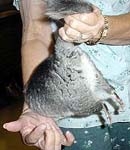
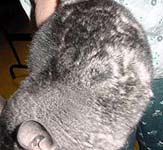
Karen explained where and how grooming should start and how to properly hold the chin while grooming it and to keep from hurting it in the process of grooming.
A chinchilla should be held by the tail, about 1/2" to 1" from the base of the tail. If you hold it to close to the base, fur can slip, to far away and you can break the tail. This picture shows you how to properly hold your chin while grooming. It does not hurt your chin.
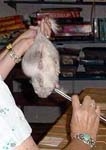
Combing the fur should start at the base of the underside of the tail, from there you go down the belly, then to the sides and back. The largest of the chinchilla combs are used in the beginning and you will work your way down to the finest toothed comb. Always make sure you have a firm, but gentle grip on the tail, sometimes the comb will tickle the chin and he will wiggle ... you do not want to drop him!
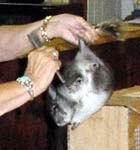
Once you have combed the entire body with the largest to the smallest comb, you need to take a 1/4" rubber hose to your chin. Keep reading ... not to hurt him ... but to rub against his fur gently. The static electricity formed by running the hose back and forth over the edges of the fur will allow most of the loose fur to cling to the hose and what little loose fur that is left will be gently removed by lent the lint roller over the tips of his fur, as seen in the pictures below.
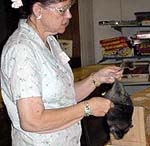
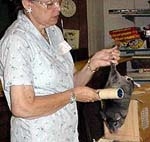
You are almost finished.
The fur on a chin's tail is thicker and stiffer than the fur on it's body. When a chin curls it's tail, it will muss the fur you have just worked so hard to get looking perfect. Now you have to trim the fur on the end of the chin's tail. You find the tip of the tail and trim the tail fur with a pair of scissors. Careful not to snip the end of it's tail ... just the fur!
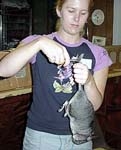
Gently shake the chin (most prefer to allow the chin to have his front paws on the table or floor when doing this) to fluff out the fur to keep it uniform and fluffy, showing no breaks or separation in the fur ... now he/she is perfectly groomed ... keep your cotton-picken-hands off the fur! Gently place the chin in the show cage by lowering his body, facing the open cage door, allowing his front paws to touch the table ... he will go into the cage, looking his best and be ready to be judged.
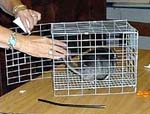 
Two cards will be placed in the card holder the first has your information on it and a second, numbered card, in front of that card to identify your chin during the judging. Judges do not know who each chin belongs to ... only the numbered card is seen by the judge.
When being judged, a chin is never touched by the judge. This could mess up the grooming you have done. Lee explained that each chin is placed on a long table covered in white paper under strong "natural lighting" bulbs. The chins being judged are of the same color division. The judge will grade each chin on bone structure, shape, fur quality, color, clarity, veiling of the color, and the over all chin. To do this, the judge will often inspect and compare different chins under the lighting to others in it's same category to choose the best chin in that category. They will also judge the belly fur for quality, color and cleanliness by raising the cage to see the underside of the chin.
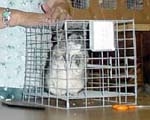
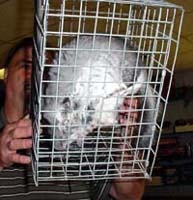
All of this and more goes into judging a chin. You want it to be at it's best, this is one of the reasons for constant and proper grooming of your chin.
This year another seminar will take place on Saturday, March 13th. This one will be on breeding, choosing mates, cage set-ups, building set-ups, mating, gestation, birth, weaning and much more. It will be held in Louisburg, NC. Everyone is welcome to attend but due to limited space, please RSVP to Jamie at: chinclub@lowcountry.com To learn more about the seminar, check out the information on it at the Huggable Pets site at: http://www.HuggablePets.com/southeast. The seminar is planned to start at 10 a.m. and will be $10 at the door. The costs will cover your lunch and drinks throughout the day. We not only learned a lot last year, but we had a great deal of fun and made many new contacts. Hope you can join us!
|
|